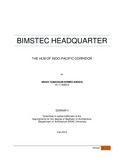| dc.contributor.author | Anisha, Anika Tabassum Ahmed | |
| dc.date.accessioned | 2016-01-12T14:42:30Z | |
| dc.date.available | 2016-01-12T14:42:30Z | |
| dc.date.copyright | 2015 | |
| dc.date.issued | 2015 | |
| dc.identifier.other | ID 11108015 | |
| dc.identifier.uri | http://hdl.handle.net/10361/4766 | |
| dc.description | This thesis is submitted in partial fulfillment of the requirements for the degree of Bachelor of Architecture, 2015. | en_US |
| dc.description | Cataloged from PDF version of thesis. | |
| dc.description | Includes bibliographical references (page 90-91). | |
| dc.description.abstract | The Bay of Bengal Initiative for Multi-Sectoral Technical and Economic Cooperation (BIMSTEC) is a regional organization comprising seven member states lying in the littoral and adjacent areas of the Bay of Bengal constituting a contiguous regional unity. This sub-regional organization came into being on 6 June 1997 through the Bangkok Declaration. It constitutes seven Member States: five deriving from South Asia, including Bangladesh, Bhutan, India, Nepal, Sri Lanka, and two from Southeast Asia, including Myanmar and Thailand.
The objective of building such an alliance was to harness shared and accelerated growth through mutual cooperation in different areas of common interests by mitigating the onslaught of globalization and by utilizing regional resources and geographical advantages. Unlike many other regional groupings, BIMSTEC is a sector-driven cooperative organization. Starting with six sectors—including trade, technology, energy, transport, tourism and fisheries—for sectoral cooperation in the late 1997, it expanded to embrace nine more sectors—including agriculture, public health, poverty alleviation, counter-terrorism, environment, culture, people to people contact and climate change.
It is indeed a matter of pride and honor for a country to hold the secretariat of such an international organization in its territorial possession. And the subliminal opportunity is getting to design its secretariat. The design has been made in accordance with its doctrinal predicaments. The design thrives to meet up its operational necessity with an added flavor of public participation. The design allows the mass people to synchronize their ideologies with the technical and diplomatic know-how of a multinational regional co-operation agency. The program is based on the following principles.
1. Supporting the full-fledged official operation of its doctrinal wings.
2. Supporting the formulation, planning and execution of BIMSTEC working principles.
3. Supporting and accommodating all of its international strategic events.
4. Supporting the bridging action between BIMSTEC policy and public participation.
5. Accommodating a common space of cultural mingling reserved to an exhibition extent; which in turns will act as a promoting factor of Bangladesh that's best referred as place branding. | en_US |
| dc.description.abstract | B. Architecture | |
| dc.description.statementofresponsibility | Anika Tabassum Ahmed Anisa | |
| dc.format.extent | 91 pages | |
| dc.language.iso | en | en_US |
| dc.publisher | BRAC University | en_US |
| dc.rights | BRAC University thesis are protected by copyright. They may be viewed from this source for any purpose, but reproduction or distribution in any format is prohibited without written permission. | |
| dc.subject | Architecture | en_US |
| dc.subject | BIMSTEC | en_US |
| dc.subject | Indo-Pacific corridor | en_US |
| dc.title | BIMSTEC headquarters: the hub of Indo-Pacific corridor | en_US |
| dc.type | Thesis | en_US |
| dc.contributor.department | Department of Architecture, BRAC University | |

